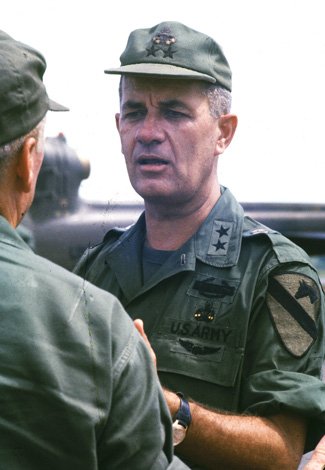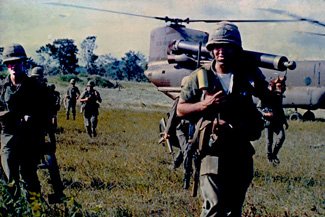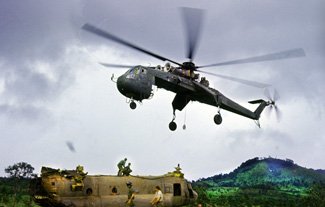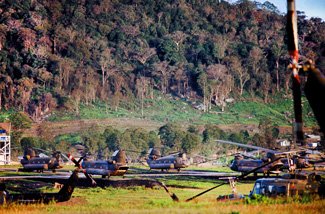The Day the Marines Asked the Army for Help, the Sun Rose in the West, and Hell Iced Over
On an October day in 1966, the sun rose in the west, a man was seen biting a dog, Hades reported ice storms—and the U.S. Marines asked the U.S. Army for help.
Okay, the first three things didn’t happen. Normally, the Marine Corps is the most self-sufficient of the armed services: Their infantry units, down to the squad, are larger than similar Army units; they can take more casualties but continue to fight effectively. The Corps has its own air element, both to establish air supremacy over the battlefield and for close support.

The CH-47 Chinook is a multipurpose helicopter that was often used to sling load heavy weapons, cargo, fuel in rubber tanks, and all sorts of military equipment. Photo courtesy of the author.
Nevertheless, on that day when a man did not bite a dog, Lt. Gen. Lewis Walt, commanding the III Marine Amphibious Force at Da Nang, Republic of Vietnam, called Maj. Gen. John Norton, commanding the 1st Cavalry Division (Airmobile) at An Khe, Republic of Vietnam, to ask for help recovering four USMC H-34 Choctaw helicopters that had been shot down.
Powered by a gigantic piston engine, the Choctaw was big and heavy. Neither the Marines nor the Navy had anything that could lift it and carry it to a secure location for repair. The Marines had therefore developed a system for retrieving a salvageable H-34: They inserted a rifle company of some 200 Marines to provide security for a recovery team. The latter included mechanics to disconnect the downed bird’s heavy transmission from its engine, then disconnect the heavy engine from the airframe. After shrouding the transmission in a net of heavy rope, a USMC H-37 helicopter—also powered by a piston engine—would hover down and fly away with the transmission. It would return and take the engine. And then return again and lift out the rest of the aircraft.
Slow, to be sure. But that was the Marines dealing with their own problem.
Now no less than four H-34s had been shot down on the warm October morning in question. Four infantry companies were deployed to protect them. Lt. Gen. Walt had an entire infantry battalion of 800 fighting men tied up on guard duty, and he wasn’t happy about it. He asked Maj. Gen. Norton if he had a helicopter that could lift out an intact H-34.

Maj. Gen. Norton, commander of the 1st Cavalry Division (Airmobile) at An Khe, Republic of Vietnam. Photo courtesy of the author.
Maj. Gen. Norton’s chief of staff called the information officer and suggested he dispatch one of his photographers to document this rare event. Maj. John Phillips, the information officer, was authorized no photographers. He had five information specialists, and one of them might have been able to handle a camera. But since he was not authorized a photographer, he was also not authorized a camera.
Fortunately, Maj. Phillips also had me. I, too, was an information specialist—then 62 days past my DEROS—date estimated return from overseas—and serving as institutional memory for a smart but very green information officer and his replacement crew. I’d spent the first six months of my Vietnam tour in the field taking combat photos with my own cameras while also teaching the other information specialists the rudiments of news photography. But by October 1966, those men had rotated home.
Award-Winning Journalism in Your Inbox
Maj. Gen. Norton dispatched two CH-47 Chinooks so that if one was shot down the other could recover it. By mid-afternoon, I was on one of them.
At Da Nang our pilots consulted the weather gods and the Marines, calculated the maximum load that they could safely lift and fly away with, and came up with a plan: We would wait until sundown, when the air began to cool and become a little denser, providing more lift to rotor blades. And each aircraft would pump out all but 1,000 pounds of fuel. The math said that we could then lift and fly with an H-34 slung beneath us.
The first pickup went off flawlessly. I was dropped near the CH-34, positioned myself to take good photos of the Marine hook-up crew as they attached the rope net to our hovering Chinook, and then photographed the liftoff and fly-away.
The other Chinook landed and I got back on. As we headed for the second pickup, the flight engineer, a staff sergeant, beckoned to me. “Sarge, are you comfortable firing Ma Deuce?” he said. “Just in case?”
Ma Deuce was the WWI vintage M2 .50-caliber machine gun mounted in the left window. I spent my first three years in the Army as an infantryman and had fired Ma Deuce a few times. In Vietnam, the only way I could accompany troops into the field on a Huey with all seats full was to replace one of the door gunners. Months earlier I graduated from the Air Cav’s ad hoc door gunner school and then flew more than 100 combat missions as a door gunner, mostly in a Huey. But I had never fired Ma Deuce from a moving helicopter.
“I need to be on the deck talking to the pilots so they can make the pickup,” he added.
“Sure,” I replied. I moved to the window and checked that the gun was ready to fire, that there was a smooth path for the ammo to climb from its box into the feeding slot, and that the gun moved smoothly vertically and horizontally.

A mortar platoon is delivered to the battlefield by a CH-47 Chinook. Photo courtesy of the author.
In minutes we were descending toward the pickup.
With the flight engineer prone on the deck, peering through a tiny window and chatting with the pilots through his headset, I took up a watch, scanning the ground, near and far. Nothing dangerous in sight except 200 Marines.
I felt our ship slowly rising, taking the slack out of the cable connected to the hook by which the recovered bird was tethered. Then we began a slow left turn to align the centers of gravity of both aircraft.
Not 50 yards away, a man in“black pajamas” and a straw hat covered with sod stood up in his spider hole. He raised a 57 mm recoilless rifle to his shoulder and took aim. I lined up my sights and fired a short burst. My bullets landed short and skipped over his head
He fired.
Our Chinook shuddered. A fist-sized hole appeared 10 feet away on my side of the fuselage. Its twin appeared on the other side. The one on my side was a hand’s span from the engine. That’s the only reason my life didn’t end in a flaming explosion.
Before I could fire again, several Marines swarmed the man in black pajamas. Meanwhile, the flight engineer jumped up, whipped off his field jacket, pulled a Bowie knife from his belt, and cut an arm off the jacket. A roll of green duct tape appeared from somewhere.
Our pilots released the cable and the H-34 fell away.
I noticed that there was an inch of hydraulic fluid sloshing around on the deck.
Hydraulic fluid, I knew, was very flammable.

A badly damaged Chinook (on the ground) is recovered by a First Air Cav CH-53 Flying Crane. The Chinook was repaired and returned to service. Photo courtesy of the author.
In half a minute, the flight engineer found the severed hydraulic line, stuffed his jacket down it, and then taped it shut.
In the cockpit, our pilots were cursing aloud and struggling with the controls. I peeked and was astonished to see both pilots with hands on the controls.
Flying a big helicopter like a CH-47 requires the assistance of hydraulics to move external control surfaces. Without them, it’s like trying to handle an 18-wheeler going full speed on an interstate without power steering or power brakes. Except that a helicopter requires maneuvering in three dimensions, not two. So our pilots worked together, announcing each maneuver and together pulling or pushing the appropriate pedal or stick.
After a long, slow, flight we landed safely at Da Nang. Trailing the pilots, I walked around the bird, shooting photos and listening to them talk.
Apparently, the 57 mm recoilless had fired a HEAT round—high explosive, antitank. It was designed to pierce through the thick armor of a tank. The HEAT round had a soft nose that collapsed on impact to shape a charge that could pierce through the armor. All this, of course, in the blink of an eye.

A CH-47 Chinook based at the Army’s First Cavalry Division base, known as the “Golf Course,” lifts off with a 105 mm howitzer on a sling. At the bottom left is the gun crew. Photo courtesy of the author.
Our Chinook was not armored. A rifle bullet easily pierced the thin aluminum hull. So the HEAT round punched a hole in one side, flew across the interior, then punched a second hole in the other side before exploding. Exploding outside our aircraft.
The paint outside the exit hole was pitted and scorched.
We were very, very lucky.
And one more thing: Our aircraft was one of the first 100 delivered by Vertol, a division of Boeing. Upon delivery, Army pilots flew several test flights and decided that the hydraulic system, although built to original specifications, was inadequate. Rather than tear it out and replace it, Vertol installed a second system, designed to act in tandem with the first.
Our Journalism Depends on Your Support
The HEAT round had severed one hydraulic line, but quick action by our flight engineer limited the loss of fluid. With great effort, our pilots controlled our flight and landed safely. Without that second system, we would have been doomed to crash.
The second Chinook recovered the remaining Marine helicopters. Mission accomplished. By morning our Chinook had been repaired. Both aircraft returned safely to An Khe.
Lt. Gen. Walt was kind enough to send a letter of thanks to every man who flew the mission.
You’re welcome, Jarheads. Any time.
This War Horse reflection was written by Marvin J. Wolf, edited by Kristin Davis, fact-checked by Jess Rohan, and copy-edited by Mitchell Hansen-Dewar. Abbie Bennett wrote the headlines.





Comments are closed.